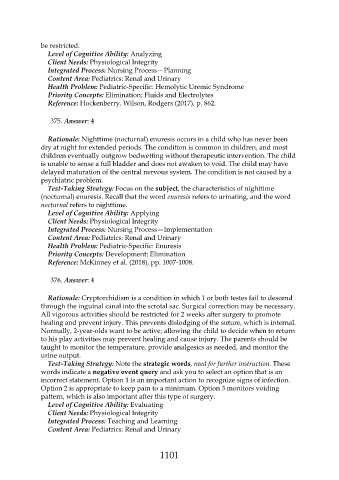Page 1101 - Saunders Comprehensive Review For NCLEX-RN
P. 1101
be restricted.
Level of Cognitive Ability: Analyzing
Client Needs: Physiological Integrity
Integrated Process: Nursing Process—Planning
Content Area: Pediatrics: Renal and Urinary
Health Problem: Pediatric-Specific: Hemolytic Uremic Syndrome
Priority Concepts: Elimination; Fluids and Electrolytes
Reference: Hockenberry, Wilson, Rodgers (2017), p. 862.
375. Answer: 4
Rationale: Nighttime (nocturnal) enuresis occurs in a child who has never been
dry at night for extended periods. The condition is common in children, and most
children eventually outgrow bedwetting without therapeutic intervention. The child
is unable to sense a full bladder and does not awaken to void. The child may have
delayed maturation of the central nervous system. The condition is not caused by a
psychiatric problem.
Test-Taking Strategy: Focus on the subject, the characteristics of nighttime
(nocturnal) enuresis. Recall that the word enuresis refers to urinating, and the word
nocturnal refers to nighttime.
Level of Cognitive Ability: Applying
Client Needs: Physiological Integrity
Integrated Process: Nursing Process—Implementation
Content Area: Pediatrics: Renal and Urinary
Health Problem: Pediatric-Specific: Enuresis
Priority Concepts: Development; Elimination
Reference: McKinney et al. (2018), pp. 1007-1008.
376. Answer: 4
Rationale: Cryptorchidism is a condition in which 1 or both testes fail to descend
through the inguinal canal into the scrotal sac. Surgical correction may be necessary.
All vigorous activities should be restricted for 2 weeks after surgery to promote
healing and prevent injury. This prevents dislodging of the suture, which is internal.
Normally, 2-year-olds want to be active; allowing the child to decide when to return
to his play activities may prevent healing and cause injury. The parents should be
taught to monitor the temperature, provide analgesics as needed, and monitor the
urine output.
Test-Taking Strategy: Note the strategic words, need for further instruction. These
words indicate a negative event query and ask you to select an option that is an
incorrect statement. Option 1 is an important action to recognize signs of infection.
Option 2 is appropriate to keep pain to a minimum. Option 3 monitors voiding
pattern, which is also important after this type of surgery.
Level of Cognitive Ability: Evaluating
Client Needs: Physiological Integrity
Integrated Process: Teaching and Learning
Content Area: Pediatrics: Renal and Urinary
1101

